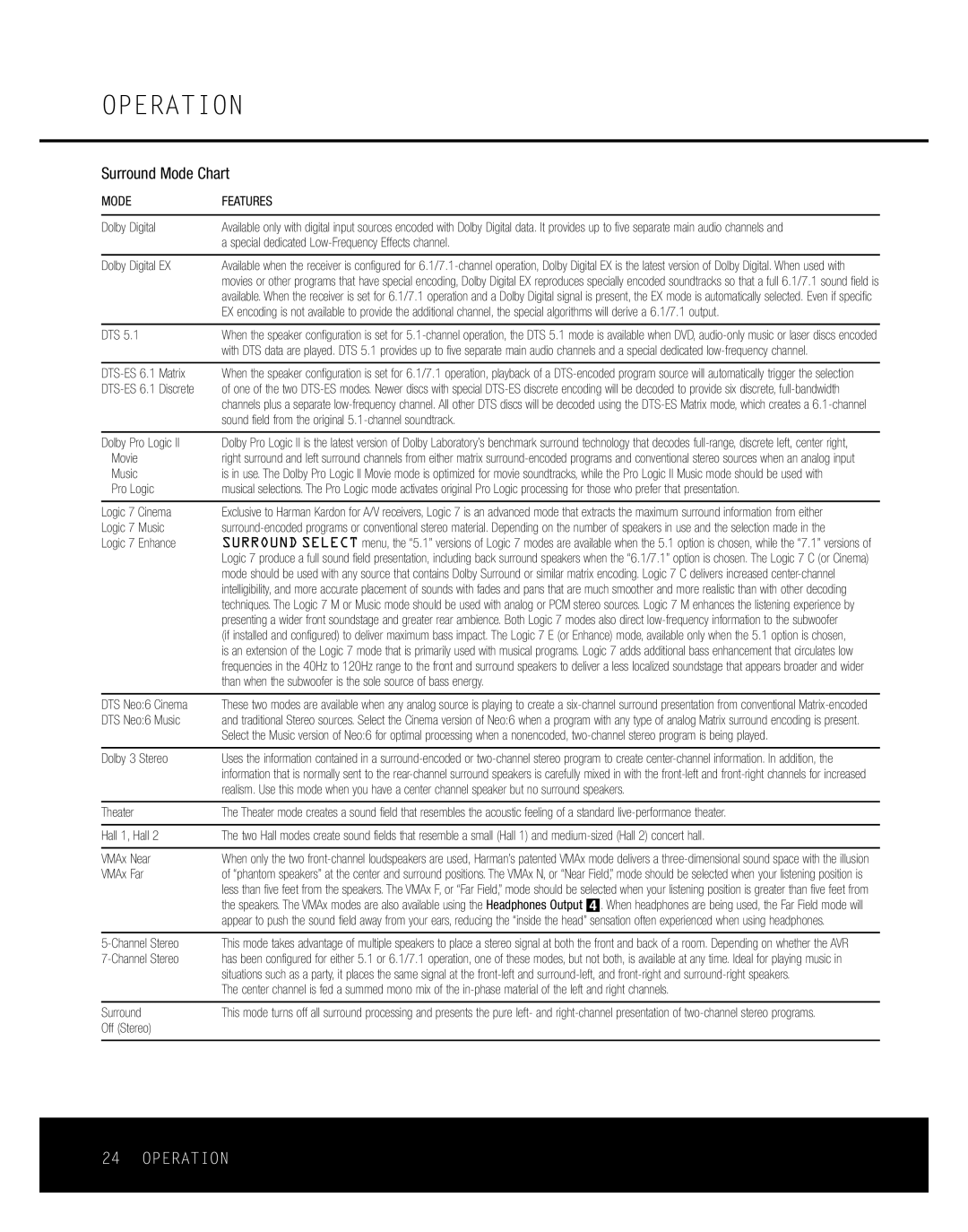
OPERATION
Surround Mode Chart
MODE | FEATURES |
|
|
Dolby Digital | Available only with digital input sources encoded with Dolby Digital data. It provides up to five separate main audio channels and |
| a special dedicated |
|
|
Dolby Digital EX | Available when the receiver is configured for |
| movies or other programs that have special encoding, Dolby Digital EX reproduces specially encoded soundtracks so that a full 6.1/7.1 sound field is |
| available. When the receiver is set for 6.1/7.1 operation and a Dolby Digital signal is present, the EX mode is automatically selected. Even if specific |
| EX encoding is not available to provide the additional channel, the special algorithms will derive a 6.1/7.1 output. |
|
|
DTS 5.1 | When the speaker configuration is set for |
| with DTS data are played. DTS 5.1 provides up to five separate main audio channels and a special dedicated |
|
|
| When the speaker configuration is set for 6.1/7.1 operation, playback of a |
| of one of the two |
| channels plus a separate |
| sound field from the original |
|
|
Dolby Pro Logic II | Dolby Pro Logic II is the latest version of Dolby Laboratory’s benchmark surround technology that decodes |
Movie | right surround and left surround channels from either matrix |
Music | is in use. The Dolby Pro Logic II Movie mode is optimized for movie soundtracks, while the Pro Logic II Music mode should be used with |
Pro Logic | musical selections. The Pro Logic mode activates original Pro Logic processing for those who prefer that presentation. |
|
|
Logic 7 Cinema | Exclusive to Harman Kardon for A/V receivers, Logic 7 is an advanced mode that extracts the maximum surround information from either |
Logic 7 Music | |
Logic 7 Enhance | SURROUND SELECT menu, the “5.1” versions of Logic 7 modes are available when the 5.1 option is chosen, while the “7.1” versions of |
| Logic 7 produce a full sound field presentation, including back surround speakers when the “6.1/7.1” option is chosen. The Logic 7 C (or Cinema) |
| mode should be used with any source that contains Dolby Surround or similar matrix encoding. Logic 7 C delivers increased |
| intelligibility, and more accurate placement of sounds with fades and pans that are much smoother and more realistic than with other decoding |
| techniques. The Logic 7 M or Music mode should be used with analog or PCM stereo sources. Logic 7 M enhances the listening experience by |
| presenting a wider front soundstage and greater rear ambience. Both Logic 7 modes also direct |
| (if installed and configured) to deliver maximum bass impact. The Logic 7 E (or Enhance) mode, available only when the 5.1 option is chosen, |
| is an extension of the Logic 7 mode that is primarily used with musical programs. Logic 7 adds additional bass enhancement that circulates low |
| frequencies in the 40Hz to 120Hz range to the front and surround speakers to deliver a less localized soundstage that appears broader and wider |
| than when the subwoofer is the sole source of bass energy. |
|
|
DTS Neo:6 Cinema | These two modes are available when any analog source is playing to create a |
DTS Neo:6 Music | and traditional Stereo sources. Select the Cinema version of Neo:6 when a program with any type of analog Matrix surround encoding is present. |
| Select the Music version of Neo:6 for optimal processing when a nonencoded, |
|
|
Dolby 3 Stereo | Uses the information contained in a |
| information that is normally sent to the |
| realism. Use this mode when you have a center channel speaker but no surround speakers. |
|
|
Theater | The Theater mode creates a sound field that resembles the acoustic feeling of a standard |
|
|
Hall 1, Hall 2 | The two Hall modes create sound fields that resemble a small (Hall 1) and |
|
|
VMAx Near | When only the two |
VMAx Far | of “phantom speakers” at the center and surround positions. The VMAx N, or “Near Field,” mode should be selected when your listening position is |
| less than five feet from the speakers. The VMAx F, or “Far Field,” mode should be selected when your listening position is greater than five feet from |
| the speakers. The VMAx modes are also available using the Headphones Output 4. When headphones are being used, the Far Field mode will |
| appear to push the sound field away from your ears, reducing the “inside the head” sensation often experienced when using headphones. |
|
|
| This mode takes advantage of multiple speakers to place a stereo signal at both the front and back of a room. Depending on whether the AVR |
has been configured for either 5.1 or 6.1/7.1 operation, one of these modes, but not both, is available at any time. Ideal for playing music in | |
| situations such as a party, it places the same signal at the |
| The center channel is fed a summed mono mix of the |
|
|
Surround | This mode turns off all surround processing and presents the pure left- and |
Off (Stereo) |
|
|
|
